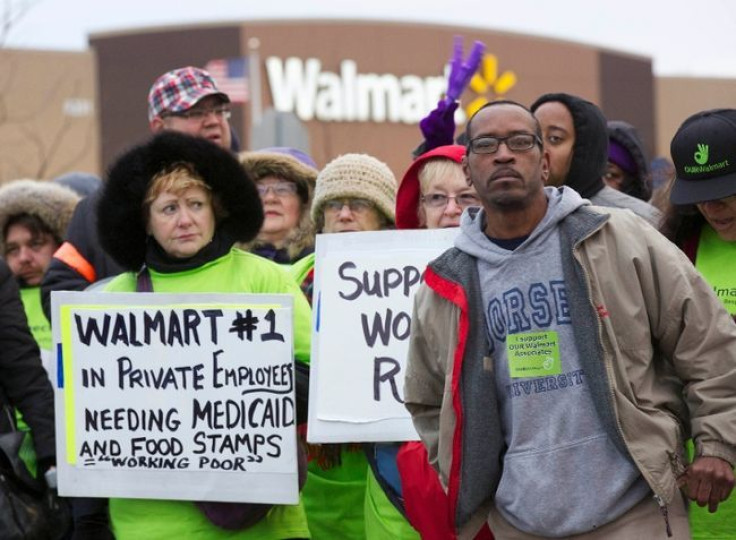US Workers Say They're Unhappy, So Why Are They Striking Less?

Once a powerful weapon of disgruntled American workers, the strike is on a steady march into labor history textbooks. The number of major work stoppages--that is, strikes or lockouts involving 1,000 workers or more--continued its four decade-long decline last year, according to data released this week by the Department of Labor. In 2014, there were 11 such stoppages, all of them strikes, the second lowest annual total since federal officials began collecting information in 1947. The low point was in 2009, at the height of the Great Recession.
By a few measures, workers today are historically unhappy: Polls show they’re disengaged from their jobs, they’re upset about the growing income gap and they’re anxious about the future. Still, only a fraction of them last year used what early 20th century labor activist Eugene Debs called “the weapon of the oppressed” and withheld their labor. Why?
For one, workers are less likely to strike when they’re feeling insecure about their employment status, says Joe McCartin, a labor history professor at Georgetown University. It’s not worth walking off the job--and running the risk of being permanently replaced--when it’s hard to find a comparable source of income. Declining unemployment figures have done little to alter that fear.
“It’s clear that recent job improvements do not translate into workers feeling like they have enough leverage to engage in a work stoppage,” McCartin says.
On top of that general sense of malaise, union density is rapidly shrinking. Last year, only 6.6 percent of private sector workers belonged to a union. Forty years ago, that figure stood above 23 percent.
“When there aren’t unions in the private sector, they don’t go on strike,” says Nelson Lichtenstein, a labor history professor at the University of California, Santa Barbara. “Unorganized workers don’t go on strike.”
It’s not just that unions are losing members. As employers keep a growing share of income gains for themselves, they’ve taken to more aggressive tactics at the bargaining table, which discourage strikes.
“Up until the late seventies and early eighties, the right to permanently replace striking workers was rarely used. Companies with unions were concerned about losing the goodwill of the union,” says Julius Getman, a professor at the University of Texas at Austin School of Law. “Then it became a management tactic. Management increasingly came to feel like they had little stake in maintaining good relations with the union.”
Under the 1935 National Labor Relations Act, the bedrock of U.S. labor law, all workers have the right to strike. However, shortly after the law passed, the Supreme Court allowed for employers to “permanently replace” workers on strike. Technically speaking, that’s not the same as firing. A striking worker who has been replaced has the right to take her old job back once the replacement leaves. But in practical terms, the difference between being “permanently replaced” and fired can be hard to discern.
Nowadays, that blurred distinction is a boon to union-wary employers and a major disincentive to discontented workers pondering a walkout. Unless strikes are over "unfair labor practices," which is how the United Steelworkers union frames its ongoing refinery strike, employees can be permanently replaced.
“Workers who decide to go on strike today have to be really angry and willing to take that risk of being replaced,” says Juliet Getman.
That’s also why so many of the strikers last year--a group that included faculty at the University of Illinois-Chicago, nurses in northern California and restaurant workers at San Francisco International Airport--resorted to one or two day work stoppages. The high-profile union-backed walkouts at fast food restaurants and Walmart stores across the country were similarly short-term. Workers who stay out much longer than that often have to worry about losing their jobs.
“What I think the labor movement is in the midst of doing is reinventing collective action and figuring out a way to engage in work stoppages without risking job losses,” says Joe McCartin. “But unless something changes, these trends will continue.”
A major overhaul of labor law is unlikely anytime soon. In 1992, a bill to prohibit employers from hiring permanent replacements for striking workers passed the House, but came up three votes short in the Senate. Any such legislation is likely dead on arrival in today’s Republican-dominated Congress.
In the meantime, says Joe Burns, a union negotiator and author, all workers suffer from the decline in strikes. Figuring out a way to revive the strike, he argues, would lift wages nationwide--not to mention, revitalize a dwindling labor movement.
“When the union movement had a powerful strike it was able to transform the wage structures of entire industries and in doing so benefit all workers union and nonunion,” he says. “That’s what forced the union and management to reach an agreement. Now, without the right to strike, collective bargaining isn’t working … and we’re seeing historic levels of inequality.”
© Copyright IBTimes 2024. All rights reserved.












